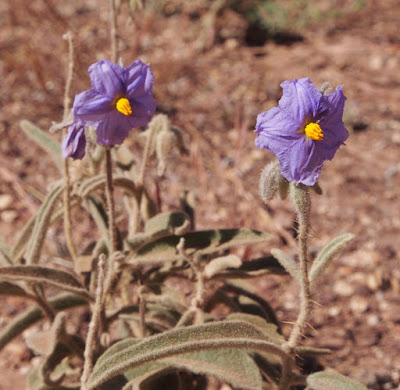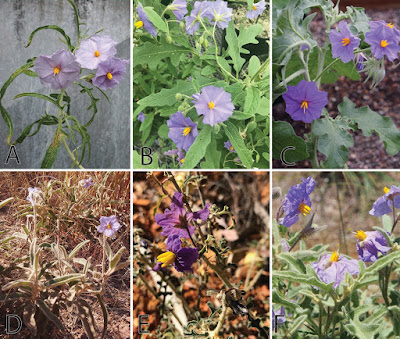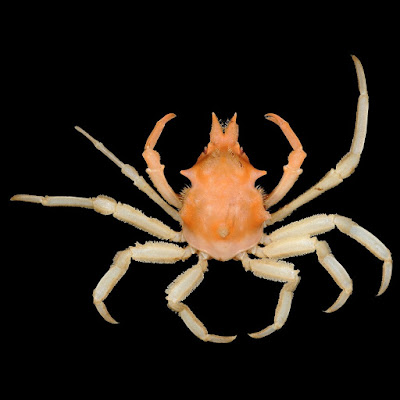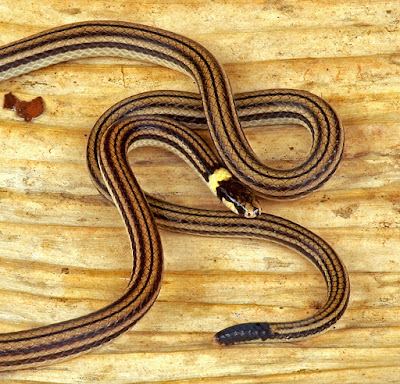[Most Recent Entries] [Calendar View]
Thursday, June 20th, 2019
| Time | Event | ||||
| 2:09a | [Botany • 2019] Solanum plastisexum (Solanaceae) • An Enigmatic New Bush Tomato from the Australian Monsoon Tropics Exhibiting Breeding System Fluidity
Abstract A bush tomato that has evaded classification by solanologists for decades has been identified and is described as a new species belonging to the Australian “Solanum dioicum group” of the Ord Victoria Plain biogeographic region in the monsoon tropics of the Northern Territory. Although now recognised to be andromonoecious, Solanum plastisexum Martine & McDonnell, sp. nov. exhibits multiple reproductive phenotypes, with solitary perfect flowers, a few staminate flowers or with cymes composed of a basal hermaphrodite and an extended rachis of several to many staminate flowers. When in fruit, the distal rachis may abcise and drop. A member of Solanum subgenus Leptostemonum, Solanum plastisexum is allied to the S. eburneum Symon species group. Morphometric analyses presented here reveal that S. plastisexum differs statistically from all of its closest relatives including S. eburneum, S. diversiflorum F. Meull., S. jobsonii Martine, J.Cantley & L.M.Lacey, S. succosum A.R.Bean & Albr. and S. watneyi Martine & Frawley in both reproductive and vegetative characters. We present evidence supporting the recognition of S. plastisexum as a distinctive entity, a description of the species, representative photographs, a map showing the distribution of members of the S. eburneum species group and a key to the andromonoecious Solanum species of the Northern Territory of Australia. This new species is apparently labile in its reproductive expression, lending to its epithet, and is a model for the sort of sexual fluidity that is present throughout the plant kingdom. Keywords: New species, andromonoecy, Solanaceae, Leptostemonum
Solanum plastisexum Martine & McDonnell, sp. nov. Diagnosis: Like Solanum eburneum, Solanum watneyi and Solanum succosum, but differing by having elliptic, unlobed (or rarely very shallowly lobed) leaves, small apical leaves, long calyx lobes on the staminate flowers and fully erect staminate inflorescence branches. ... Etymology: The name is based on the Latin “plastus” (“deceptive,” but derived from the Greek “plastikos/plasticos/plasticus” for “able to be molded, changeable”) and the Latin “sexus” for sex. We suggest the use of Dungowan Bush Tomato for the common name of this species, which refers to the cattle station on which the majority of the collections have been made. Angela J. McDonnell, Heather B. Wetreich, Jason T. Cantley, Peter Jobso and Christopher T. Martine. 2019. Solanum plastisexum, An Enigmatic New Bush Tomato from the Australian Monsoon Tropics Exhibiting Breeding System Fluidity. PhytoKeys 124: 39-55. DOI: 10.3897/phytokeys.124.33526 Meet Australia’s New Sex-Changing Tomato: Solanum plastisexum nyti.ms/2MSzL01 Scientists challenge notion of binary sexuality with naming of new plant species eurekalert.org/e/9J0Z via @Pensoft @EurekAlert | ||||
| 2:50a | [Crustacea • 2019] Deep-sea Spider Crabs of the Family Epialtidae MacLeay, 1838 (Decapoda: Brachyura: Majoidea), from Papua New Guinea, with A Redefinition of Tunepugettia and Descriptions of Two New Genera; Crocydocinus & Neophrys
Abstract The deep-water epialtid spider crab (superfamily Majoidea) material collected from recent French expeditions to Papua New Guinea (BIOPAPUA 2010, PAPUA NIUGINI 2012, MADEEP 2014, and KAVIENG 2014) was studied. In addition to several new records for the country, five new species of Oxypleurodon Miers, 1885, Rochinia A. Milne-Edwards, 1875, and Tunepugettia Ng, Komai & Sato, 2017, are described. The taxonomy of Tunepugettia is reappraised, and a new genus, Crocydocinus n. gen., is established, characterised by its smooth ambulatory legs and a distinct male first gonopod structure. Four species from the Bay of Bengal, Sumatra, and Réunion Island, currently placed in Rochinia and Tunepugettia are transferred to Crocydocinus n. gen. and four new species from Papua New Guinea, Philippines, and Vanuatu are described. A new genus, Neophrys n. gen., with one new species from Papua New Guinea, is established, and is characterised by the supraorbital eave being fused with the carapace and the poorly developed pre-orbital angle. Keywords: Crustacea, Papua New Guinea, spider crabs, Epialtidae, taxonomy, new genera, new species, deep-sea Bee Yan Lee, Bertrand Richer de Forges and Peter K. L. Ng. 2019. Deep-sea Spider Crabs of the Family Epialtidae MacLeay, 1838, from Papua New Guinea, with A Redefinition of Tunepugettia Ng, Komai & Sato, 2017, and Descriptions of Two New Genera (Crustacea: Decapoda: Brachyura: Majoidea). Zootaxa. 4619(1); 1–44. DOI: 10.11646/zootaxa.4619.1.1 | ||||
| 2:58a | [Herpetology • 2019] On the Occurrence of Apostolepis phillipsi (Serpentes, Elapomorphini) in Brazil, with the Description of A New Specimen from Mato Grosso
Abstract We describe a specimen of Apostolepis phillipsi Harvey, 1999, from Vila Bela da Santíssima Trindade, Mato Grosso, establishing the first unambiguous record of the species in Brazil. The new locality is ca. 120 km from the type locality, in Bolivia. We present an updated species diagnosis, the first image of a living specimen, and the first description of A. phillipsi coloration in life. Even though the Brazilian range of A. phillipsi lies within a protected area (Parque Estadual Serra Ricardo Franco—PESRF), it is threatened by cattle raising, logging and agriculture. PESRF lacks formal delimitation and a management plan, and the Mato Grosso State Legislature is considering a decree to extinguish PESRF, which could cause the extirpation of the Brazilian range of several endemic species. Keywords: Reptilia, snake, Cerrado, Serra de Ricardo Franco, Bolivia, conservation Guarino Rinaldi Colli, André Felipe Barreto-Lima, Pedro Tourinho Dantas, Carlos José S Morais, Arthur de Sena and Heitor Campos de Sousa. 2019. On the Occurrence of Apostolepis phillipsi (Serpentes, Elapomorphini) in Brazil, with the Description of A New Specimen from Mato Grosso. Zootaxa. 4619(3); 580–588. DOI: 10.11646/zootaxa.4619.3.11 | ||||
| 3:13a | [Ichthyology • 2019] Morphology and Molecular Evidence support the Validity of Pogonias courbina (Lacepède, 1803) (Teleostei: Sciaenidae), with A Redescription and Neotype Designation
Abstract The family Sciaenidae comprises about 300 species. The black drum Pogonias cromis was the only valid species of the genus. Herein, Pogonias courbina Lacepède 1803 is redescribed based on morphological and molecular evidence and a neotype is designated. Pogonias courbina is distinguished by the following characters: the occurrence of characteristic thickening of the dorsal spines VII to XI in all specimens larger than 250 mm SL; all pterygiophores in the dorsal-fin laminar, thin; anal-fin pterygiophores slender excluded those of spines; lateral projections of gas bladder with few finger-like projections; genetic distance between both species 1%; exclusive occurrence of characters in six informative sites of COI (58 G; 214 G; 328 A; 331 A; 553C; 580 G). The method Automatic Barcode gap Discovery detected gaps in nucleotid distance congruent with the NJ, MP, and ML tree analysis. Also, advertisement calls are three times shorter in duration in P. courbina than in P. cromis. In addition, two monophyletic groups for P. cromis and P. courbina appear in trees obtained with different methodologies, emphasizing the absence of shared haplotypes. A gap of about 8000 km occurs in the distribution of both species along coastal areas of the Atlantic Ocean.
Pogonias courbina (Lacepède, 1803) Pogonathus courbina Lacepède 1803: 120. Type locality: Rio de la Plata Diagnosis: Pogonias courbina is distinguished from P. cromis by the characteristic hyperostoses in the spines of the central part of dorsal fin of all specimens over 250 mm SL (vs hyperostose absent); by having all pterygiophores in the dorsal fin always laminar and thin (vs dorsal-fin pteygiophores broad); pterygiophores of anal fin slender excluded those of the anal spines (vs anal.fin pterygiophores broad); gas bladder with lateral processes simple (vs anterior and lateral processes complex); advertisement call short,120–200 milliseconds (vs advertisement call long, 600±22 ms). Genetic distance between P. cromis and P. courbina 1%. A compound nucleotide diagnostic discriminates between P. cromis and P. courbina by the exclusive occurrence of characters in six informative sites of COI (58 G; 214 G; 328 A; 331 A; 553C; 580 G). ... María de las Mercedes Azpelicueta , Sergio Matías Delpiani, Alberto Luis Cione, Claudio Oliveira, Alexandre Pires Marceniuk and Juan Martín Díaz de Astarloa. 2019. Morphology and Molecular Evidence support the Validity of Pogonias courbina (Lacepède, 1803) (Teleostei: Sciaenidae), with A Redescription and Neotype Designation. PLoS ONE. 14(6): e0216280. DOI: 10.1371/journal.pone.0216280 |
| << Previous Day |
2019/06/20 [Calendar] |
Next Day >> |










